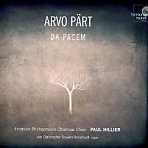If you know the choral music of Arvo Pärt and are familiar with Paul Hillier’s previous performances and recordings of Pärt’s works, it’s no surprise that this current release is another first-rate effort in all respects. However, I must admit that on first glance at a new Pärt disc I’m often confused by the list of works. I think I’ve seen and heard some or all of them before, on the last release, on the one before that–and indeed, Pärt justifiably has been a favorite of a handful of conductors and choirs, from Hillier’s Hilliard Ensemble (ECM), Theatre of Voices (Harmonia Mundi), and Estonian Philharmonic Chamber Choir (also with Tonu Kaljuste), to Stephen Layton’s Polyphony (Hyperion) and Noel Edison’s Elora Festival Singers (Naxos). And on closer inspection, certain pieces–Magnificat, Salve Regina, Nunc dimittis, I am the True Vine, De Profundis, Bogoroditse Djevo, and Dopo la vittoria–have received favored attention on many recordings, even by the same choirs on different releases. Even the present program features one track from 2004, the increasingly popular Dopo la vittoria, that also appeared on last year’s Arvo Pärt–A Tribute (type Q9172 in Search Reviews).
But, in addition to new material, Hillier also offers new versions of works he’s recorded before with other groups, such as Magnificat and An den Wassern zu Babel. Among the most recent works, the title track, Da pacem Domine (2004), is as near-perfect an evocation of text as the composer has ever achieved–and typically he does this not through any overt gesture, but through more subtle techniques, including an almost complete subordination of rhythmic influence and the relegation of melody to a more or less implied presence, thus forming both his framework and expressive fabric from the most elemental materials–sonority, voicing, and rudimentary harmonies. The harmonies slowly shift and turn and change color, and there’s a true sense of direction–but there is no discernible tempo or metrical pattern; rather, the music’s effect is made over longer, larger stretches of space and time, the sensation of movement like the deep, easy rise-and-fall breathing of some great yet placid being. (Or perhaps the feeling of motion and the music’s concurrent changes in hue and texture could be compared to looking across a plain from a moving car to distant mountains, their shapes gradually changing, and the shifting light and perspective creating continually varied shadows and shades of color.) Importantly, the periodic open-ended, unresolved soprano interjections throughout the piece are an ingeniously effective illustration of the prayer’s air of both uncertainty and profound hope.
There are many more worthy moments and highlights here–just waiting for each listener to discover. But to describe them all would also be to unduly focus on another aspect of Pärt’s writing–a kind of subliminal sameness that’s both reassuring and hypnotic, but that also becomes a distraction, its relative importance exaggerated when listening to an entire disc of similar-styled works at one sitting. The bias toward minor thirds in both melodic and harmonic contexts, the pervasive use of antiphonal choral effects, the chord inversions that give a sense of suspended time, the slow-moving harmonic changes unbound by traditional metrical or temporal constraints–all of these in some way define Pärt’s post-1976 music. But ultimately, the proof is in receptive, unanalytical listening, and no matter how many times you hear Pärt’s works, each time you’re somehow carried beyond an expected esthetic experience to a more spiritual place–whether you want to be or not. And that’s something Hillier and his singers know well, evidenced by their pure, unadorned affirmations of this eloquently plain music. Other composers have tried to achieve this kind of elegance and simplicity (John Tavener has tried and failed time and time again), but Pärt has the artistic sincerity, integrity, and skill to fully realize it. [10/4/2006]
































